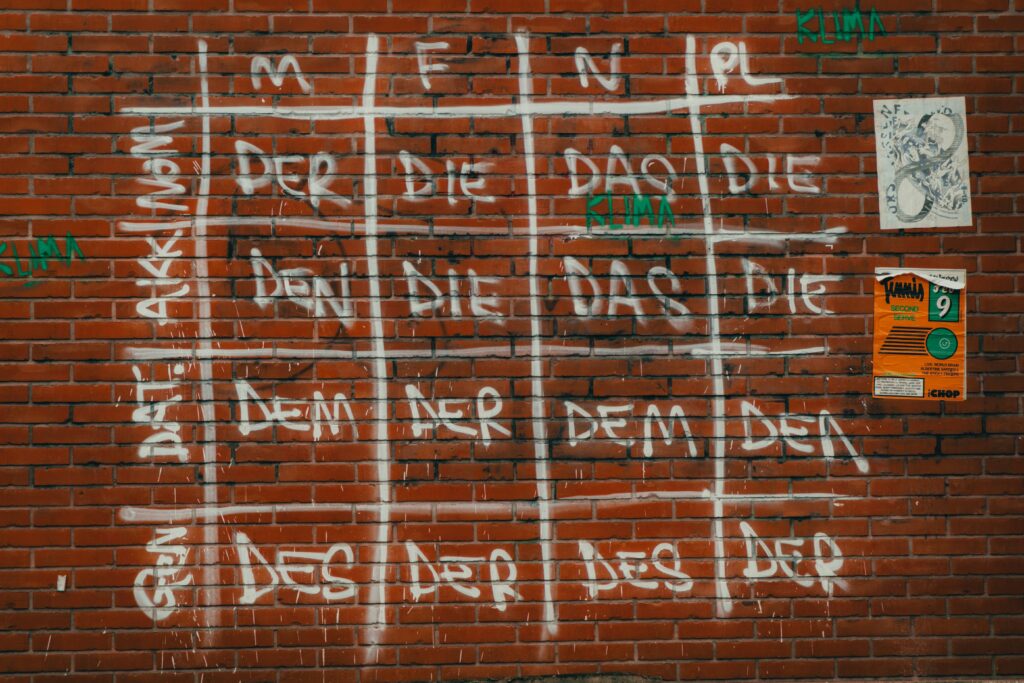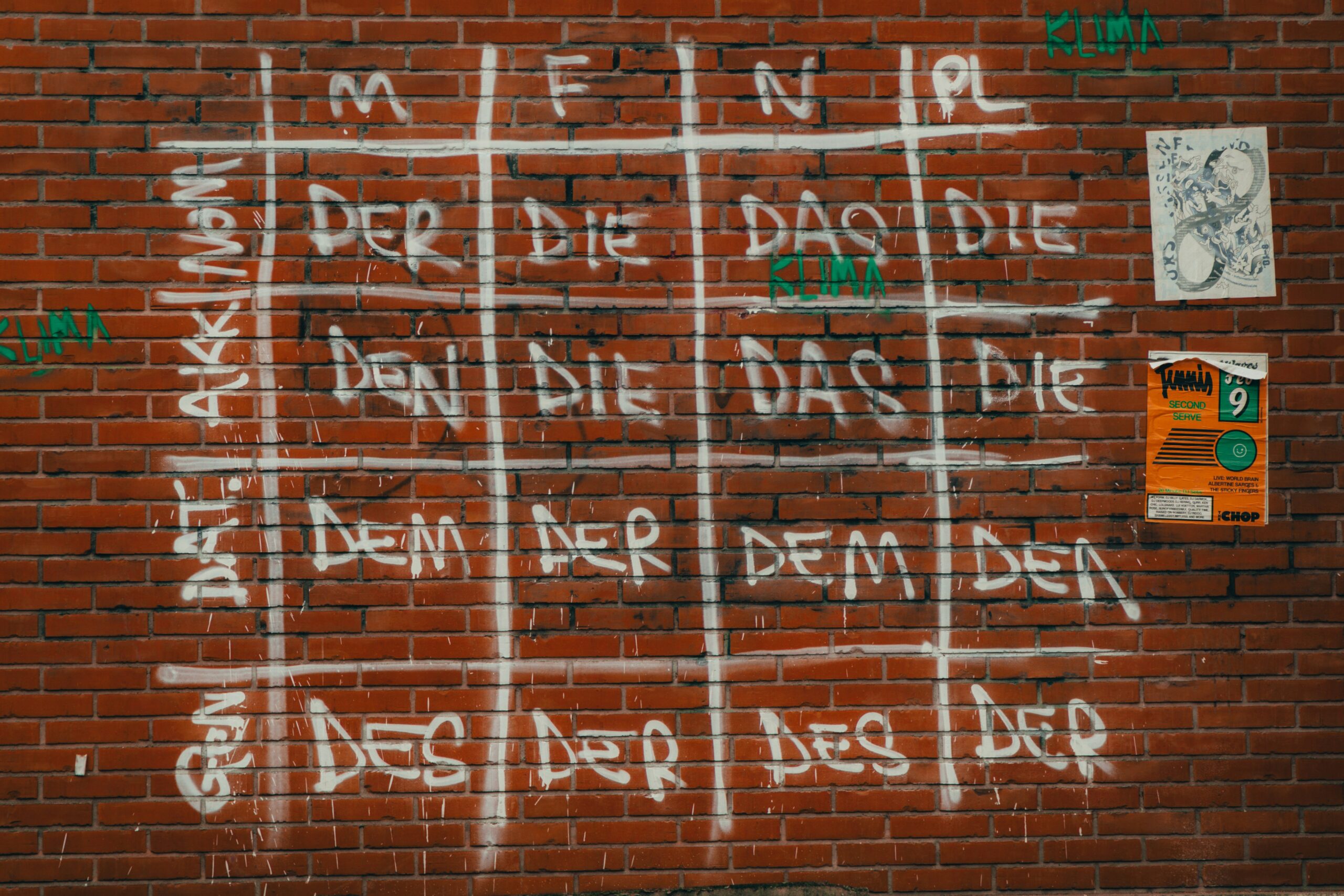
One of the most challenging aspects for learners of the German language is mastering its gender system. Unlike English, which uses a single definite article “the,” German assigns nouns to three grammatical genders: masculine (der), feminine (die), and neuter (das). For many students, this system seems arbitrary and unnecessarily complex. But why does German, and many other languages, have gendered nouns at all? Is there a logical structure behind it, or is it merely a quirk of linguistic evolution? In this article, we will explore the origins, functions, and peculiarities of grammatical gender in German from a linguistic perspective.
1. The Historical Roots of Grammatical Gender
A. Proto-Indo-European Origins
German is part of the Indo-European language family, which includes English, Spanish, Russian, Greek, and many others. Linguists believe that the ancestor of these languages, Proto-Indo-European (PIE), had an early form of grammatical gender.
Originally, PIE likely had only two gender categories: animate (referring to living things) and inanimate (referring to objects and abstract concepts). Over time, the animate category split into masculine and feminine, while inanimate nouns became neuter. This three-way distinction carried over into several modern Indo-European languages, including Latin, Greek, and German.
B. The Development into Germanic Languages
As Proto-Indo-European branched into Proto-Germanic, the system of three grammatical genders was maintained. Old High German, an early stage of German, had gender distinctions similar to what we see today. Unlike English, which simplified and ultimately lost grammatical gender, German retained and reinforced its system over the centuries.
The persistence of gender in German is partly due to how case and word endings function. Old English, a close relative of Old High German, originally had gendered nouns, but as English grammar simplified, case endings disappeared, making gender distinctions unnecessary. German, on the other hand, preserved these inflections, making gender a key part of its grammar.
2. The Function of Grammatical Gender in German
While grammatical gender may seem like a random classification system, it actually serves several linguistic purposes:
A. Aiding Sentence Structure and Clarity
Because German has a flexible word order due to its case system (nominative, accusative, dative, and genitive), grammatical gender helps clarify meaning. For example:
- Der Hund sieht die Katze. (The dog sees the cat.)
- Die Katze sieht den Hund. (The cat sees the dog.)
In English, switching word order would change the meaning of the sentence, but in German, gendered articles and case endings indicate who is performing the action.
B. Establishing Agreement Between Words
In German, adjectives, pronouns, and determiners must agree with the gender of the noun. This adds coherence and consistency to sentences. For example:
- Der große Tisch (The big table – masculine)
- Die schöne Blume (The beautiful flower – feminine)
- Das kleine Haus (The small house – neuter)
This agreement system helps speakers quickly recognize which words are connected in a sentence.
C. Influencing Pronouns and Reference Words
Gender in German extends beyond definite articles (der, die, das). It affects possessive pronouns, relative pronouns, and demonstratives:
- Wo ist mein Buch? Es liegt auf dem Tisch. (Where is my book? It is on the table.)
- Ich mag die Stadt. Sie ist sehr schön. (I like the city. It is very beautiful.)
Here, “es” refers to “das Buch” (neuter), and “sie” refers to “die Stadt” (feminine). Gender helps maintain sentence cohesion by ensuring proper reference to nouns.
3. Patterns and Rules for Gender Assignment
While some noun genders seem arbitrary, many follow consistent patterns:
A. Masculine Nouns (Der)
- Nouns ending in -er: der Lehrer (teacher), der Computer (computer)
- Nouns referring to male people: der Mann (man), der Vater (father)
- Days, months, seasons: der Montag (Monday), der Sommer (summer)
- Most alcoholic beverages: der Wein (wine), der Whisky (whiskey)
B. Feminine Nouns (Die)
- Nouns ending in -e: die Blume (flower), die Lampe (lamp)
- Nouns ending in -ung, -heit, -keit, -ion: die Rechnung (bill), die Freiheit (freedom)
- Most nouns referring to female people: die Frau (woman), die Mutter (mother)
- Most names of ships and airplanes: die Titanic (Titanic), die Boeing 747
C. Neuter Nouns (Das)
- Nouns ending in -chen, -lein (diminutives): das Mädchen (girl), das Büchlein (little book)
- Nouns referring to young animals and babies: das Baby (baby), das Kätzchen (kitten)
- Most foreign loanwords: das Hotel (hotel), das Restaurant (restaurant)
- Most metals and chemical elements: das Gold (gold), das Eisen (iron)
4. The Challenge of Gender in German Learning
Many learners struggle with noun gender in German because it often doesn’t align with logic. For example:
- Das Mädchen (The girl) is neuter because of the diminutive -chen suffix.
- Die Sonne (The sun) is feminine, but der Mond (The moon) is masculine—opposite of some other languages like French.
Because there are exceptions, memorization is often necessary, though recognizing common patterns can help reduce the difficulty.
5. Do Other Languages Have Similar Gender Systems?
German is not alone in using grammatical gender. Other languages include:
- French, Spanish, Italian: Have two genders (masculine, feminine)
- Russian, Greek, Icelandic: Have three genders (like German)
- English, Chinese, Japanese: No grammatical gender
Some languages, like Dutch and Swedish, historically had three genders but have simplified to two in modern use.
6. Could German Ever Lose Its Gender System?
Languages evolve, and simplification is common. English lost its gender system over time, and some German dialects (such as in spoken Swiss German) simplify gender rules. However, because gender agreement is deeply embedded in German grammar, it is unlikely to disappear anytime soon.
Conclusion: Why German Maintains Its Gender System
Grammatical gender in German is a product of linguistic history, structure, and function. While challenging for learners, it plays a vital role in sentence clarity, word agreement, and linguistic consistency. Although it may feel arbitrary at times, there are recognizable patterns that make learning gender easier over time.
For learners, the best approach is to accept gender as part of the language’s character and use memory aids, exposure, and practice to internalize noun genders naturally. Despite its complexity, the German gender system is one of the many features that make the language both unique and fascinating!
